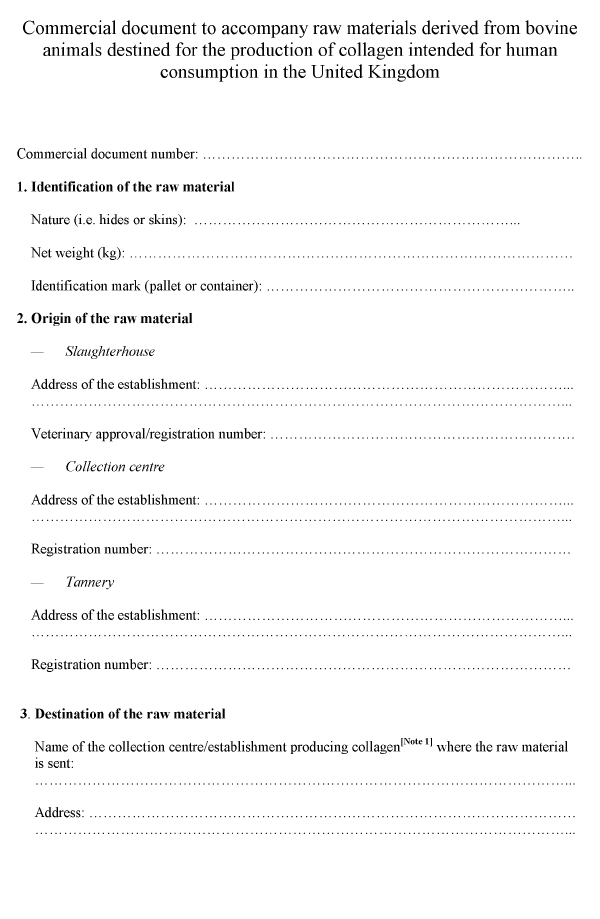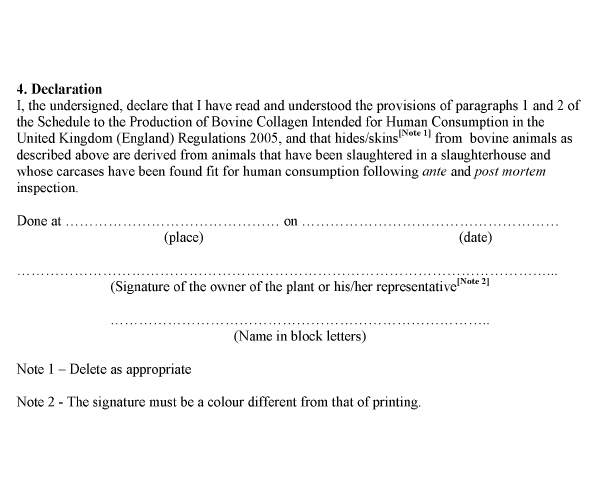- Latest available (Revised)
- Point in Time (26/03/2005)
- Original (As made)
The Production of Bovine Collagen Intended for Human Consumption in the United Kingdom (England) Regulations 2005 (revoked)
You are here:
- UK Statutory Instruments
- 2005 No. 404
- Schedules only
- Show Geographical Extent(e.g. England, Wales, Scotland and Northern Ireland)
- Show Timeline of Changes
More Resources
Status:
Point in time view as at 26/03/2005.
Changes to legislation:
There are currently no known outstanding effects for the The Production of Bovine Collagen Intended for Human Consumption in the United Kingdom (England) Regulations 2005 (revoked).![]()
Changes to Legislation
Revised legislation carried on this site may not be fully up to date. At the current time any known changes or effects made by subsequent legislation have been applied to the text of the legislation you are viewing by the editorial team. Please see ‘Frequently Asked Questions’ for details regarding the timescales for which new effects are identified and recorded on this site.
Regulation 6
THE SCHEDULEE+W
PART 1 E+WGeneral provisions
Raw materials and establishments supplying raw materialsE+W
1.—(1) Only the hides and skins of bovine animals may, subject to sub-paragraph (2), be used as raw materials for the production of collagen intended for human consumption in the United Kingdom.
(2) The use as raw materials of hides and skins submitted to tanning processes is prohibited.
(3) Raw materials shall be derived from bovine animals which have been slaughtered in a slaughterhouse and whose carcases have been found fit for human consumption following ante and post mortem inspection.
(4) Raw materials shall come from slaughterhouses, collection centres or tanneries.
(5) Collection centres and tanneries supplying raw materials shall be authorised under regulation 6 of the Collagen and Gelatine (Intra–Community Trade) (England) (No. 2) Regulations 2003 M1.
Marginal Citations
Transport and storage of raw materialsE+W
2.—(1) Raw materials destined for the production of collagen shall be transported under clean conditions using appropriate means of transport.
(2) Subject to sub-paragraph (3) raw materials shall be transported and stored in a chilled or frozen state, unless they are processed within 24 hours of dispatch.
(3) Salted, dried and limed hides and skins and hides and skins treated with alkali or acid may be transported and stored at ambient temperature.
(4) Storage rooms shall be kept in a satisfactory state of cleanliness and repair, so that they do not constitute a source of contamination for the raw materials.
(5) During transportation and at the time of delivery at collection centres and establishments producing collagen, raw materials shall be accompanied by a commercial document in accordance with the model laid down in Part 2 of this Schedule.
Establishments producing collagenE+W
3.—(1) The production of collagen intended for human consumption shall take place in an establishment authorised under regulation 7 of the Collagen and Gelatine (Intra–Community Trade) (England) (No. 2) Regulations 2003.
(2) There shall be implemented at the establishment a system that makes it possible to link each production batch dispatched with the associated incoming raw material consignments, the production conditions and the time of production.
Manufacture of collagenE+W
4.—(1) Collagen shall be produced by a process that ensures that the raw material is subjected to a treatment involving washing, pH adjustment using acid or alkali followed by one or more rinses, filtration and extrusion.
(2) Collagen produced in accordance with sub-paragraph (1) shall undergo no further processing other than a drying process.
(3) Collagen not intended for human consumption shall not be produced and stored in the same establishment as collagen intended for human consumption unless the collagen not intended for human consumption is produced and stored under the same conditions as set out in this Schedule.
(4) The use of preservatives other than those permitted under European Parliament and Council Directive 95/2/EC on food additives other than colours and sweeteners M2 (as that Directive is amended as at the date these Regulations are made), is prohibited.
Marginal Citations
M2OJ No. L61, 18.3.95, p.1, as last amended by Directive 2003/114/EC of the European Parliament and of the Council (OJ No. L24, 29.1.2004, p.58).
Finished productsE+W
5.—(1) Appropriate measures, including tests, shall be taken to ensure that, subject to sub-paragraph (2), each production batch of collagen meets the microbiological and residues criteria set out in the Table in Part 3 of this Schedule.
(2) Where the nature of a finished product is such that it would be inappropriate to require it to comply with the moisture and ash limits specified in Part 3 of this Schedule, those limits shall not apply to that product.
Wrapping, packaging, storage and transportE+W
6.—(1) Collagen intended for human consumption must be wrapped, packaged, stored and transported under satisfactory hygiene conditions, and in particular —
(a)a room must be provided for storing, wrapping and packaging materials;
(b)wrapping and packaging must take place in a room or in a place intended solely for that purpose.
(2) Wrappings and packages containing collagen must —
(a)bear an identification mark giving the following particulars —
(i)the name “United Kingdom” or initial letters “UK”,
(ii)followed by the registration number of the establishment and the initials “EC”; and
(b)carry the words “Collagen fit for human consumption in the United Kingdom”; and
(c)bear the date of preparation and the batch number.
(3) Collagen must be accompanied during transportation by a commercial document which must bear —
(a)the words “Collagen fit for human consumption in the United Kingdom”; and
(b)the date of preparation and the batch number.
PART 2 E+W
PART 3 E+WMicrobiological and residues criteria for collagen intended for human consumption
| Microbiological criteria | |
|---|---|
| Microbiological parameters | Limit |
| Total aerobic bacteria | 103/g |
| Coliforms (30°C) | 0/g |
| Coliforms (44.5°C) | 0/10g |
| Anaerobic sulphite–reducing bacteria (no gas production) | 10/g |
| Clostridium perfringens | 0/g |
| Staphylococcus aureus | 0/g |
| Salmonella | 0/25g |
| Residues | |
| Elements | Limit |
| As | 1 ppm |
| Pb | 5 ppm |
| Cd | 0.5 ppm |
| Hg | 0.15 ppm |
| Cr | 10 ppm |
| Cu | 30 ppm |
| Zn | 50 ppm |
| Moisture (105°C) | 15% |
| Ash (550°C) | 2% |
| SO2 (Reith Williems) | 50 ppm |
| H2O2 (European Pharmacopia 1986 (V2O2)) | 10 ppm |
Options/Help
Print Options
PrintThe Whole Instrument
PrintThe Schedules only
Legislation is available in different versions:
Latest Available (revised):The latest available updated version of the legislation incorporating changes made by subsequent legislation and applied by our editorial team. Changes we have not yet applied to the text, can be found in the ‘Changes to Legislation’ area.
Original (As Enacted or Made): The original version of the legislation as it stood when it was enacted or made. No changes have been applied to the text.
Point in Time: This becomes available after navigating to view revised legislation as it stood at a certain point in time via Advanced Features > Show Timeline of Changes or via a point in time advanced search.
See additional information alongside the content
Geographical Extent: Indicates the geographical area that this provision applies to. For further information see ‘Frequently Asked Questions’.
Show Timeline of Changes: See how this legislation has or could change over time. Turning this feature on will show extra navigation options to go to these specific points in time. Return to the latest available version by using the controls above in the What Version box.
Explanatory Memorandum
Explanatory Memorandum sets out a brief statement of the purpose of a Statutory Instrument and provides information about its policy objective and policy implications. They aim to make the Statutory Instrument accessible to readers who are not legally qualified and accompany any Statutory Instrument or Draft Statutory Instrument laid before Parliament from June 2004 onwards.
More Resources
Access essential accompanying documents and information for this legislation item from this tab. Dependent on the legislation item being viewed this may include:
- the original print PDF of the as enacted version that was used for the print copy
- lists of changes made by and/or affecting this legislation item
- confers power and blanket amendment details
- all formats of all associated documents
- correction slips
- links to related legislation and further information resources
Timeline of Changes
This timeline shows the different points in time where a change occurred. The dates will coincide with the earliest date on which the change (e.g an insertion, a repeal or a substitution) that was applied came into force. The first date in the timeline will usually be the earliest date when the provision came into force. In some cases the first date is 01/02/1991 (or for Northern Ireland legislation 01/01/2006). This date is our basedate. No versions before this date are available. For further information see the Editorial Practice Guide and Glossary under Help.
More Resources
Use this menu to access essential accompanying documents and information for this legislation item. Dependent on the legislation item being viewed this may include:
- the original print PDF of the as made version that was used for the print copy
- correction slips
Click 'View More' or select 'More Resources' tab for additional information including:
- lists of changes made by and/or affecting this legislation item
- confers power and blanket amendment details
- all formats of all associated documents
- links to related legislation and further information resources


